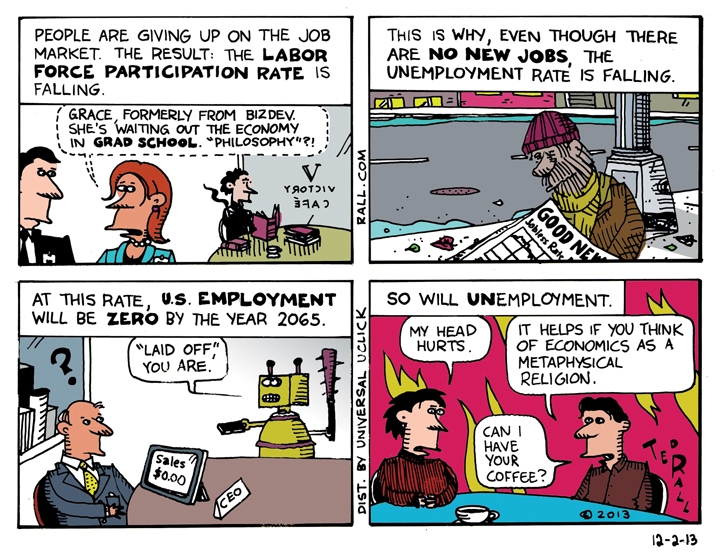Welcome to the paradox of falling labor participation rate: as people drop out of the workforce, we’re moving closer to a time when unemployment is zero at the same time that there are no jobs left.
Zero Employment = Zero Unemployment

Ted Rall
Ted Rall is a syndicated political cartoonist for Andrews McMeel Syndication and WhoWhatWhy.org and Counterpoint. He is a contributor to Centerclip and co-host of "The Final Countdown" talk show on Radio Sputnik. He is a graphic novelist and author of many books of art and prose, and an occasional war correspondent. He is, recently, the author of the graphic novel "2024: Revisited."

9 Comments. Leave new
I always thought it obscene that some level of unemployment (3 or 4 % or whatever the masterminds come up with) is considered to be ZERO, the excess considered transitional.
This translates into some people being unable to maintain themselves when the system is performing AS DESIGNED, and yet the unemployed are blamed as if they created the problem.
It has always bothered me that when an unemployed person reaches the maximum of benefits and cannot apply or report anymore, that person drops out of sight and is no longer considered “unemployed” in the statistics. That’s something of a distortion, don’t you think?
It’s not as if one turns into an air plant when jobs aren’t available.
It sure is a distortion. If the unemployment rate today included those who dropped out of the labor force since 2008, the official unemployment rate would be 10% and the unofficial rate would be 20%.
So true. The goal should always be total unemployment. But without joblessness, labor might have some power to negotiate with management.
Goal = “total unemployment” (?)
“Ted, do you need a proof-reader?” asks the retired former English teacher.
😀
The only meaningful measure of employment and under/unemployment is the percentage of the population in the relevant age group which is working full or part-time, studying, on sick or parental leave, etc. Measurement of the percentage of those «available to the labour market» who actually have jobs is, as Ted demonstrates here, so easily manipulated as to be devoid of meaning. What a surprise that it is precisely this latter which is used as the yardstick in the US !…
Henri
The 4% = full employment is because: a) we always have school leavers every year, and with lots of jobs, they spend more time optimising; and b) with lots of jobs, people will quit work, go some place they’ve always wanted to see, spent a few months looking around and optimising. Once the official rate is more than 4%, there is real unemployment, and it’s always more than the official rate. That’s basic non-Tea economics.
To be unemployed, you must have applied to some place that’s taking applications. So, as Mr Rall says, once there are no jobs, once no one is taking applications, there will be no unemployment. Again, that just follows from the definition. A tautology.
(And I saw this cartoon dramatised back in a ’50s Twilight Zone: First, the executive, who had a pocket watch that he constantly twirled, replaced all the factory workers with automatic machines, then he was replaced by a robot that could make managerial decisions, and the robot had a pocket watch that it twirled.)
This is a bit off-topic, but relates to “The Twilight Zone” which I always watched faithfully. What sticks in my mind is the episode where a man was submitting his ration-card to the bureaucrat behind the counter who insisted it was not valid (or needed up-dating or whatever) and insisted that he could receive no food until next month. When next month came, he presented his card again for his government-issued rations, successfully. She asked, “By the way, how did you lose your arm?” It was obvious that the family was forced to eat his flesh in order to survive.